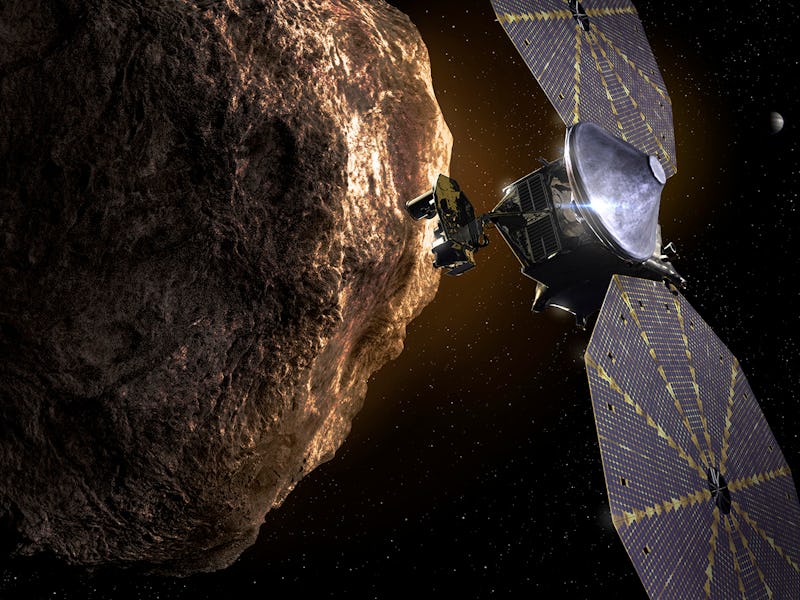NASA’s bold new asteroid mission just took off — here’s what happens next
NASA has successfully launched its Lucy mission to explore the history of the Solar System. Here's what comes next.

Liftoff! NASA’s Lucy mission successfully launched on Saturday, a step toward understanding more about the Solar System’s history.
The United Launch Alliance Atlas V rocket lifted off at 5:34 a.m. Eastern time on October 16. The rocket launched from Space Launch Complex 41 at Cape Canaveral Space Force Station in Florida. On board was the Lucy spacecraft, which will explore one asteroid in the Solar System’s main belt and seven Trojan asteroids in Jupiter’s orbit.
It’s a historic moment for the agency, as it marks the first time exploring so many asteroids on a single mission. The 12-year voyage will see the spacecraft visit the mysterious Trojan asteroids near Jupiter, which are leftovers of the building blocks that formed the major planets of the outer Solar System.
Artist's impression of the Trojan asteroids.
Perhaps it’s apt, then, that the mission is called Lucy — the name references an early known ancestor discovered in 1974, which revealed more about humanity’s origin story. That skeleton was, in turn, named after the Beatles’ song “Lucy in the Sky with Diamonds.”
“Lucy is going back in the sky with diamonds!” the song’s writer, Ringo Starr, said in a recorded video:
“Lucy embodies NASA’s enduring quest to push out into the cosmos for the sake of exploration and science, to better understand the universe and our place within it,” NASA administrator Bill Nelson said in a statement. “I can’t wait to see what mysteries the mission uncovers!”
The early beginnings of the mission are mixed. NASA reported on Saturday that the satellite sent its first signal back to Earth at 6: 40 a.m. Eastern time to the NASA Deep Space Network.
NASA’s Lucy mission launches on a ULA Atlas V rocket.
However, in a Sunday blog post, NASA reported that one of the spacecraft’s two solar arrays may not have latched properly. The spacecraft is otherwise operating as expected, and both solar arrays are deployed and producing power. The team will now analyze the data to understand the situation.
As Lucy travels across the Solar System at around 67,000 mph, here’s what comes next.
NASA Lucy mission: What is the goal?
The agency chose Lucy in 2017 to explore the Trojan asteroids. Harold F. Levison, Lucy's principal investigator from Southwest Research Institute (SwRI) in Boulder, Colorado, said in 2017 that these asteroids are “remnants of the primordial material that formed the outer planets.”
Studying them could reveal more about the Solar System’s history. The asteroids form two groups, both of which orbit the Sun along the same orbit as Jupiter. While around 6,500 asteroids had been spotted in the groups by 2017, Lucy will only study seven of them.
NASA's photo of the ULA Atlas V taking off.
Following the launch of the mission, Lucy will orbit the Sun and swing back toward the Earth. The return, set for around October 2022, will give Lucy a gravity assist advantage that it can use to complete its journey. It will then swing back to Earth for another gravity assist in 2024 before reaching the Donaldjohanson asteroid in the main belt by 2025.
Lucy's asteroids lined up.
Following this encounter, Lucy will move toward the first Trojan group in 2027.
Lucy's trajectory mapped.
It will then swing back to Earth in time for a third boost by 2031 and encounter asteroids in the second Trojan group in 2033.
The ULA Atlas V rocket standing tall.
NASA Lucy mission: What does NASA plan to do next?
Fresh from discovering more about the Solar System’s past, NASA plans to peer into space’s present and protect Earth’s future.
The agency plans to launch the Double Asteroid Redirection Test, or DART, during a launch window that opens on November 24. The mission will launch from a SpaceX Falcon 9 rocket taking off from Vandenberg Space Force Base in California.
The goal of DART is to develop a system for preventing asteroids from impacting Earth. DART will do this by crashing into the moonlet Didymos.
Following this mission, NASA also plans to launch the James Webb Space Telescope no earlier than December 18. The mission will lift off from French Guiana using an Ariane 5 rocket.
The telescope was developed by NASA, the European Space Agency, and the Canadian Space Agency. It features a giant mirror measuring 21.3 feet — the Hubble Space Telescope, by comparison, measures less than eight feet.
Lucy is just the beginning.